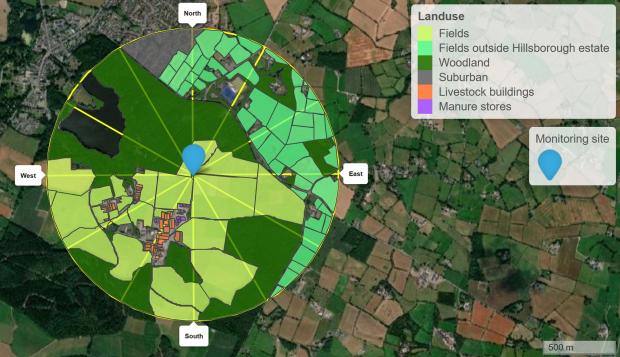- The AFBI Hillsborough research farm has 280 dairy cows; 100 suckler cows, 250 ewes and 140 breeding sows and farms a total of 450ha. As such it is one of the largest livestock farms in Northern Ireland
- AFBI Hillsborough research programmes focus in leading improvements in livestock production systems, enhancing the natural environment, especially in terms of water and air quality and protecting animal health and welfare
- The concentration of ammonia in the air is being monitored in real time, minute-by-minute on the research farm
- Ammonia concentrations in the air can be linked to local farm activities and local weather conditions
- AFBI Hillsborough is located over 10 km away from the closest terrestrial priority habitat and does not contribute significantly to nitrogen deposition at any site
- ‘Live’ data is publicly available to raise awareness of cause and effect
AFBI Hillsborough research farm

The dairy herd comprises approximately 280 Holstein/Friesian dairy cows plus young-stock. The herd is within the top 1% of UK herds for PLI (Profitable Lifetime Index), with an average milk yield of approximately 8000 kg/year. The beef rearing unit has 100 suckler cows. The sheep flock consists of 250 breeding ewes, mainly Lleyn and Texel crosses. With a lambing rate of 1.93, approximately 480 lambs are produced and sold from the flock every year. The pig enterprise comprises approximately 140 Landrace/Large White breeding sows, with all offspring being reared on the farm and a small proportion being sold off as weaners
A wide range of research programmes are conducted within each enterprise into areas such as sustainable livestock systems with a focus on production efficiency and environmental issues. AFBI Hillsborough also has specialist experimental facilities with a key focus on gaseous emissions from livestock systems. These include metabolic chambers, nutrient digestibility enclosures and mobile gas measurement system (SF6) which are used to measure all losses to the environment of gases, fluids, solids and heat from individual animals during environmental impact studies. The farm also has a 600 cubic metre mesophilic Anaerobic Digester which mainly utilises dairy cow manure, but also pig manure and crop materials.
The key drivers of ammonia concentration in the air are farm activities, air temperature, wind speed and direction and rainfall. These factors also affect local dispersion across the wider landscape. As such, weather conditions, as well as ammonia concentrations, are being measured continuously (minute-by-minute) in a field near the AFBI Hillsborough farmyard (Figure 1). The researchers are using this valuable data to conduct detailed modelling to examine the relationships between farm activities, climatic factors and how they affect ammonia levels that are measured in the air. Over time, as additional ammonia abatement strategies are adopted on the AFBI Hillsborough farm, the effects upon local air quality will be monitored and quantified.
In addition, the study allows for real-time information to be made publicly available, to both stakeholders and the wider public to help them enhance their understanding of ammonia as an air pollutant, its sources and the interactions between agricultural activities on the farm and weather.
